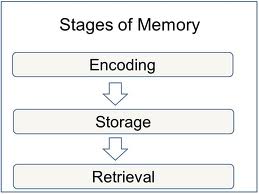Retaining Information in Shortterm Memory Simply by Repeating It Over and Over Again
Introduction to the Process and Types of Memory
Memory is the ability to take in information, encode it, store it, and retrieve it at a later time.
Learning Objectives
Summarize which types of memory are necessary to which stage of the process of memory storage
Key Takeaways
Key Points
- The three main stages of memory are encoding, storage, and retrieval. Problems can occur at any of these stages.
- The three main forms of memory storage are sensory memory, short-term memory, and long-term memory.
- Sensory memory is not consciously controlled; it allows individuals to retain impressions of sensory information after the original stimulus has ceased.
- Short-term memory lasts for a very brief time and can only hold 7 +/- 2 pieces of information at once.
- Long-term storage can hold an indefinitely large amount of information and can last for a very long time.
- Implicit and explicit memories are two different types of long-term memory. Implicit memories are of sensory and automatized behaviors, and explicit memories are of information, episodes, or events.
Key Terms
- memory: The ability of an organism to record information about things or events with the facility of recalling them later at will.
- rehearsal: Repetition of an item in short-term memory in order to store it in long-term memory.
Memory is the ability to take in information, store it, and recall it at a later time. In psychology, memory is broken into three stages: encoding, storage, and retrieval.

Stages of memory: The three stages of memory: encoding, storage, and retrieval. Problems can occur at any stage of the process.
The Memory Process
- Encoding (or registration): the process of receiving, processing, and combining information. Encoding allows information from the outside world to reach our senses in the forms of chemical and physical stimuli. In this first stage we must change the information so that we may put the memory into the encoding process.
- Storage: the creation of a permanent record of the encoded information. Storage is the second memory stage or process in which we maintain information over periods of time.
- Retrieval (or recall, or recognition): the calling back of stored information in response to some cue for use in a process or activity. The third process is the retrieval of information that we have stored. We must locate it and return it to our consciousness. Some retrieval attempts may be effortless due to the type of information.
Problems can occur at any stage of the process, leading to anything from forgetfulness to amnesia. Distraction can prevent us from encoding information initially; information might not be stored properly, or might not move from short-term to long-term storage; and/or we might not be able to retrieve the information once it's stored.
Types of Memory
Sensory Memory
Sensory memory allows individuals to retain impressions of sensory information after the original stimulus has ceased. One of the most common examples of sensory memory is fast-moving lights in darkness: if you've ever lit a sparkler on the Fourth of July or watched traffic rush by at night, the light appears to leave a trail. This is because of "iconic memory," the visual sensory store. Two other types of sensory memory have been extensively studied: echoic memory (the auditory sensory store) and haptic memory (the tactile sensory store). Sensory memory is not involved in higher cognitive functions like short- and long-term memory; it is not consciously controlled. The role of sensory memory is to provide a detailed representation of our entire sensory experience for which relevant pieces of information are extracted by short-term memory and processed by working memory.
Short-Term Memory
Short-term memory is also known as working memory. It holds only a few items (research shows a range of 7 +/- 2 items) and only lasts for about 20 seconds. However, items can be moved from short-term memory to long-term memory via processes like rehearsal. An example of rehearsal is when someone gives you a phone number verbally and you say it to yourself repeatedly until you can write it down. If someone interrupts your rehearsal by asking a question, you can easily forget the number, since it is only being held in your short-term memory.
Long-Term Memory
Long-term memories are all the memories we hold for periods of time longer than a few seconds; long-term memory encompasses everything from what we learned in first grade to our old addresses to what we wore to work yesterday. Long-term memory has an incredibly vast storage capacity, and some memories can last from the time they are created until we die.
There are many types of long-term memory. Explicit or declarative memory requires conscious recall; it consists of information that is consciously stored or retrieved. Explicit memory can be further subdivided into semantic memory (facts taken out of context, such as "Paris is the capital of France") and episodic memory (personal experiences, such as "When I was in Paris, I saw the Mona Lisa").
In contrast to explicit/declarative memory, there is also a system for procedural/implicit memory. These memories are not based on consciously storing and retrieving information, but on implicit learning. Often this type of memory is employed in learning new motor skills. An example of implicit learning is learning to ride a bike: you do not need to consciously remember how to ride a bike, you simply do. This is because of implicit memory.
langdonthissinat1964.blogspot.com
Source: https://courses.lumenlearning.com/boundless-psychology/chapter/introduction-to-memory/